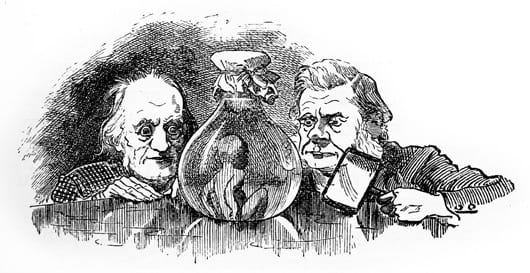
Ponzi Scheme Examples: Revealing Notable Cases
Updated Sept 2023
We will delve into the concept of Ponzi scheme examples within a historical context, as those who fail to learn from history are destined to repeat it.
The recent revelations regarding the U.S. Treasury’s financial operations have raised concerns about the resemblance of its financing model to a Ponzi scheme. The Treasury’s reliance on issuing new debt to pay off old debt and finance deficit spending has striking similarities to the fraudulent investment scheme that the Securities and Exchange Commission (SEC) defines as a Ponzi scheme.
In just eight weeks since fiscal 2015 began, the Treasury has been compelled to issue a staggering $1,040,965,000,000 in new debt. This enormous amount was necessary to cover the maturing Treasury securities and the escalating deficit spending by the government. Although the Treasury collected a record-breaking $341,591,000,000 in revenues during this period, it fell short of financing the ongoing government expenditures and repaying the old debt.
To manage the $942,103,000,000 in maturing debt and accommodate the new deficit spending, the Treasury resorted to a strategy reminiscent of a Ponzi scheme. It effectively rolled over the old debt into new debt and issued additional debt to cover the expanding deficit. This approach relies on an influx of funds from new investors to pay returns to existing investors, creating an illusion of financial stability. However, without legitimate earnings to sustain it, the scheme relies on a constant flow of new investments to sustain itself.
The SEC highlights that Ponzi schemes tend to collapse when it becomes difficult to attract new investors or when many investors request to withdraw their funds. This collapse occurs when the financial foundation of the scheme proves unsustainable, leading to significant financial losses for participants.
Drawing parallels between the Treasury’s financing approach and a Ponzi scheme raises essential questions about the long-term implications and risks associated with the government’s financial operations. While the Treasury’s actions are legally sanctioned and differ in purpose from a fraudulent investment scheme, the similarities in the mechanics of financing are concerning.
The Treasury’s growing reliance on issuing new debt to cover existing debt and finance government spending raises concerns about its ability to sustain this model. It highlights the challenges of balancing revenue generation and fiscal responsibility. If the Treasury faces difficulties in attracting new investors or experiences a decline in revenues, it could encounter significant challenges in meeting its financial obligations.
Moreover, the implications of such a financing model extend beyond the Treasury itself. The stability of the economy, the value of the U.S. dollar, and the trust of investors are all interconnected factors that can be influenced by the Treasury’s financial practices. A collapse or loss of confidence in the Treasury’s ability to manage its debt could have far-reaching consequences for the economy and society as a whole.
It is essential for policymakers and financial experts to carefully monitor and address these concerns to ensure the long-term financial stability and well-being of the country. Evaluating alternative approaches to managing debt, reducing deficit spending, and generating sustainable revenues should be priorities to mitigate the risk of a financial crisis.
While the comparison between the Treasury’s financing model and a Ponzi scheme serves as a cautionary note, it is important to recognize that the Treasury’s operations are governed by legal frameworks and regulatory oversight. Nonetheless, the exposure of such similarities highlights the need for prudent financial management and transparent policies to maintain public trust and safeguard the integrity of the financial system.
Ponzi Scheme Examples Unveiled: Treasury Secrets and the Looming Debt Dilemma
“In a gripping testimony delivered before the Senate Finance Committee in October 2013, Secretary Lew revealed the urgency of Congress agreeing to increase the federal debt limit. He articulated why the Treasury had no alternative but to issue new debt continually.
“Secretary Lew emphasized the staggering reality: ‘Every week, we find ourselves rolling over approximately $100 billion in U.S. bills.’ He cautioned that if U.S. bondholders ever decided to demand repayment instead of continually reinvesting, it could suddenly deplete our entire cash reserve.
“‘There is no viable strategy apart from raising the debt limit that allows us to honour all our commitments,’ Lew asserted firmly.
“However, buried within this narrative is an undeniable truth. Someday, a critical question will arise: ‘Why should we extend further loans? You stand financially vulnerable, and there’s little assurance of repayment.’ This query, when asked, may set off a seismic shift, igniting a firestorm that could erode the strength of the mighty dollar.”
Notorious Ponzi Schemes: Deception, Dollars, and Downfalls
Here are four examples of Ponzi schemes and a brief description of each:
1. Bernie Madoff’s Ponzi Scheme:
Bernie Madoff orchestrated one of the most infamous Ponzi schemes in history. Operating for several decades, Madoff defrauded investors out of billions of dollars. He promised consistently high returns and used new investors’ funds to pay off existing investors. The scheme collapsed in 2008 during the global financial crisis, leading to Madoff’s arrest and a significant loss for investors.
2. Charles Ponzi’s Scheme:
Charles Ponzi, after whom the Ponzi scheme is named, ran a fraudulent investment scheme in the 1920s. He promised investors high returns through international postal reply coupons. However, Ponzi was not actually investing in these coupons but using new investors’ funds to pay off earlier investors. His scheme crumbled when it became unsustainable, ultimately leading to his arrest and conviction.
3. Allen Stanford’s Ponzi Scheme:
Allen Stanford, a former financier and cricket entrepreneur, ran a massive Ponzi scheme through his banking institution, Stanford International Bank. He lured investors with promises of high returns on certificates of deposit. However, he misappropriated the funds for personal use and to sustain the scheme. In 2009, the scheme was exposed, and Stanford was convicted of multiple charges, including fraud.
4. Zeek Rewards Ponzi Scheme:
Zeek Rewards was an online penny auction website that also operated a Ponzi scheme. Investors were promised high returns for purchasing bids and promoting the platform. The scheme relied on new investments to pay existing investors and collapsed in 2012 when regulatory authorities shut it down. The mastermind, Paul Burks, was charged and sentenced for orchestrating the fraudulent scheme.
Originally Published on August 10, 2015, but Continuously Updated Over the Years, the Latest Update Was Completed in September 2023.
Perspectives: Pushing Boundaries of Knowledge










